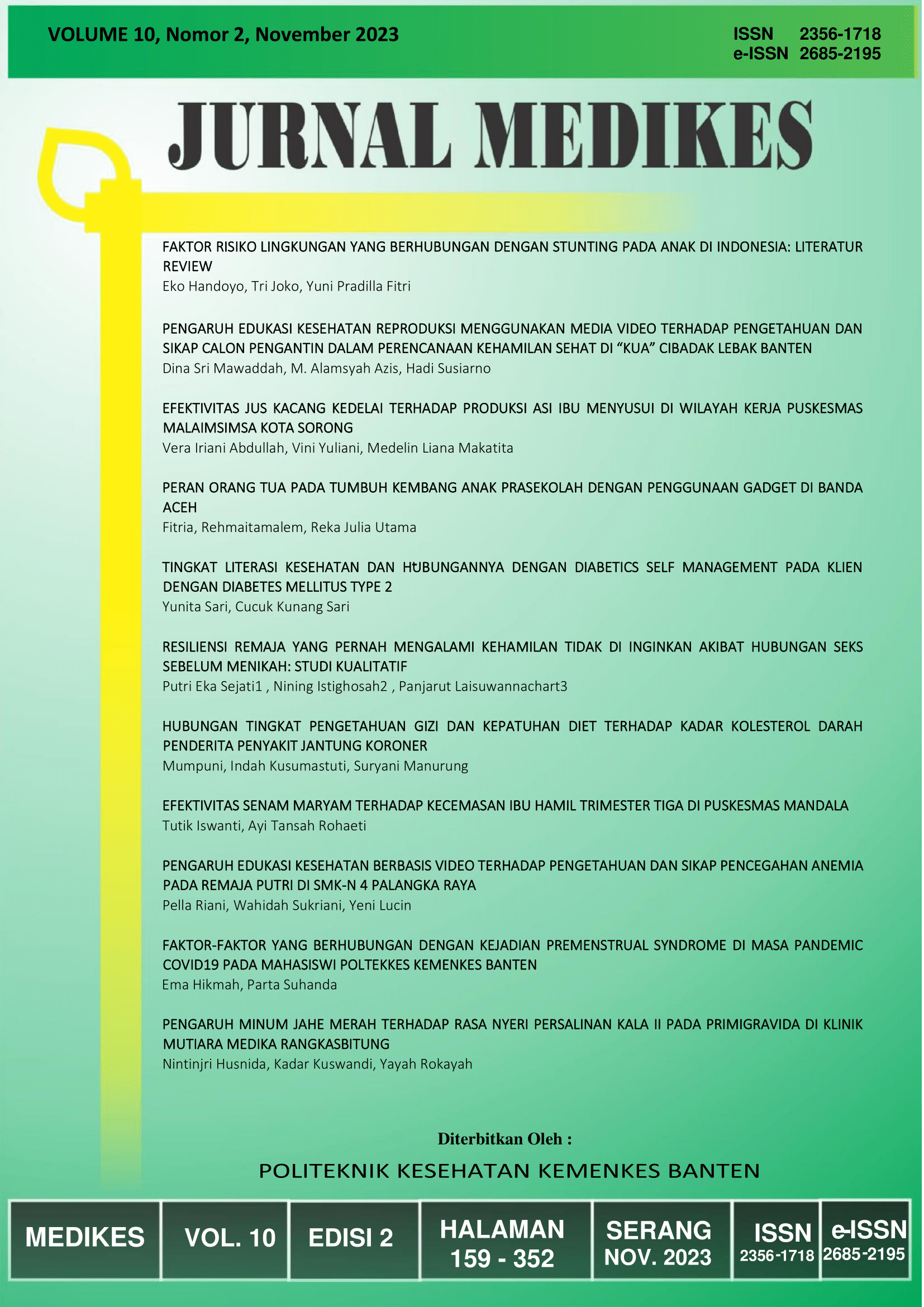FAKTOR RISIKO LINGKUNGAN YANG BERHUBUNGAN DENGAN STUNTING PADA ANAK DI INDONESIA: LITERATUR REVIEW
DOI:
https://doi.org/10.36743/medikes.v10i2.509Keywords:
water, sanitation, hygiene, stuntingAbstract
Stunting is a disorder of growth and development of children due to chronic malnutrition and recurrent infections, which is characterized by the length or height below the standard. Indonesia is included in the third country with the highest prevalence in the Southeast Asia region. The results of the 2018 Basic Health Research (Riskesdas) show that the prevalence of stunting in under-five children in Indonesia is 30.8%. In 2022, through the Indonesian Nutrition Status Survey (SSGI) the stunting prevalence in under-five children in Indonesia has decreased to 21.6%. The purpose of this study was to determine environmental risk factors for stunting. The method in this study uses the literature review method by selecting data sources according to the desired topics and criterias. The database used in the source search is google scholar and ejournal.undip.ac.id, with the keywords water, sanitation, hygiene, and stunting. The results of studies from 10 scientific journals on environmental risk factors for stunting show that water, sanitation and hygiene are risk factors for stunting.
References
Alfadhila Khairil Sinatrya and Lailatul Muniroh (2019) ‘Hubungan Faktor Water, Sanitation, and Hygiene (WASH) dengan Stunting di Wilayah Kerja Puskesmas Kotakulon, Kabupaten Bondowoso ’, Amerta Nutrition, 3(3), pp. 164–170. Available at: https://doi.org/10.2473/amnt.v3i3.2019.164-170.
Badan Pusat Statistik, J.I. (2018) Laporan Indek Khusus Penanganan Stunting 2018-2019.
Cumming, O. and Cairncross, S. (2016) ‘Can water, sanitation and hygiene help eliminate stunting? Current evidence and policy implications’, Maternal and Child Nutrition, 12, pp. 91–105. Available at: https://doi.org/10.1111/mcn.12258.
Dwipayanti, N.M.U. et al. (2020) ‘Potential Association of Sanitation Factors on Stunting Incidences Among Children Under Age 5 in Bali Province, Indonesia’, 22(Ishr 2019), pp. 24–28. Available at: https://doi.org/10.2991/ahsr.k.200215.005.
Goddard, F.G.B. et al. (2020) ‘Faecal contamination of the environment and child health: a systematic review and individual participant data meta-analysis’, The Lancet Planetary Health, 4(9), pp. e405–e415. Available at: https://doi.org/10.1016/S2542-5196(20)30195-9.
Herawati, H., Anwar, A. and Setyowati, D.L. (2020) ‘Hubungan Sarana Sanitasi, Perilaku Penghuni, dan Kebiasaan Cuci Tangan Pakai Sabun (CTPS) oleh Ibu dengan Kejadian Pendek (Stunting) pada Batita Usia 6-24 Bulan di Wilayah Kerja Puskesmas Harapan Baru, Samarinda’, Jurnal Kesehatan Lingkungan Indonesia, 19(1), p. 7. Available at: https://doi.org/10.14710/jkli.19.1.7-15.
Irianti, S. et al. (2019) ‘The role of drinking water source, sanitation, and solid waste management in reducing childhood stunting in Indonesia’, IOP Conference Series: Earth and Environmental Science, 344(1). Available at: https://doi.org/10.1088/1755-1315/344/1/012009.
Jensen, S.K.G., Berens, A.E. and Nelson, C.A. (2017) ‘Effects of poverty on interacting biological systems underlying child development’, The Lancet Child and Adolescent Health, 1(3), pp. 225–239. Available at: https://doi.org/10.1016/S2352-4642(17)30024-X.
Kementerian PPN/ Bappenas (2018) ‘Pedoman Pelaksanaan Intervensi Penurunan Stunting Terintegrasi di Kabupaten/Kota’, Rencana Aksi Nasional dalam Rangka Penurunan Stunting: Rembuk Stunting, (November), pp. 1–51. Available at: https://www.bappenas.go.id.
Mulyaningsih, T. et al. (2021) ‘Beyond personal factors: Multilevel determinants of childhood stunting in Indonesia’, PLoS ONE, 16(11 November), pp. 1–19. Available at: https://doi.org/10.1371/journal.pone.0260265.
Nurjazuli, N. et al. (2023) ‘Environmental factors related to children diagnosed with stunting 3 years ago in Salatiga City, Central Java, Indonesia’, Toxicologie Analytique et Clinique, (xxxx), pp. 1–8. Available at: https://doi.org/10.1016/j.toxac.2023.01.003.
Otsuka, Y. et al. (2019) ‘Risk factors for undernutrition and diarrhea prevalence in an urban slum in Indonesia: Focus on water, sanitation, and hygiene’, American Journal of Tropical Medicine and Hygiene, 100(3), pp. 727–732. Available at: https://doi.org/10.4269/ajtmh.18-0063.
Purba, I.G. et al. (2020) ‘Environmental Sanitation and Incidence of Stunting in Children Aged 12-59 Months in Ogan Ilir Regency’, Jurnal Kesehatan Lingkungan, 12(3), p. 189. Available at: https://doi.org/10.20473/jkl.v12i3.2020.189-199.
Rizal, M.F. and van Doorslaer, E. (2019) ‘Explaining the fall of socioeconomic inequality in childhood stunting in Indonesia’, SSM - Population Health, 9, p. 100469. Available at: https://doi.org/10.1016/j.ssmph.2019.100469.
Siswati, T. (2019) ‘Risk factors for stunting among children under five years’, 8(11), p. 21.
Torlesse, H. et al. (2016) ‘Determinants of stunting in Indonesian children: Evidence from a cross-sectional survey indicate a prominent role for the water, sanitation and hygiene sector in stunting reduction’, BMC Public Health, 16(1), pp. 1–11. Available at: https://doi.org/10.1186/s12889-016-3339-8.
UNICEF (2020) ‘Panduan Cuci Tangan Pakai Sabun’, Kesehatan Lingkungan, pp. 1–34. Available at: https://kesmas.kemkes.go.id/assets/upload/dir_519d41d8cd98f00/files/Panduan_CTPS2020_1636.pdf.
WHO (2019) Interpretation guide, Nutrition landscape information system (NLIS) Country Profile. Available at: www.who.int/nutrition.
WHO and UN (2021) ‘Compendium of WHO and other UN guidance on health and environment-NC-SA 3.0 IGO licence’.
Wispriyono, B. et al. (2021) ‘Peran Hygiene dan Sanitasi terhadapEscherichia coli Pencemaran pada Air Minum di Kota Depok , Indonesia’, 9, pp. 641–644.
Downloads
Published
How to Cite
Issue
Section
License

This work is licensed under a Creative Commons Attribution-NonCommercial 4.0 International License.




